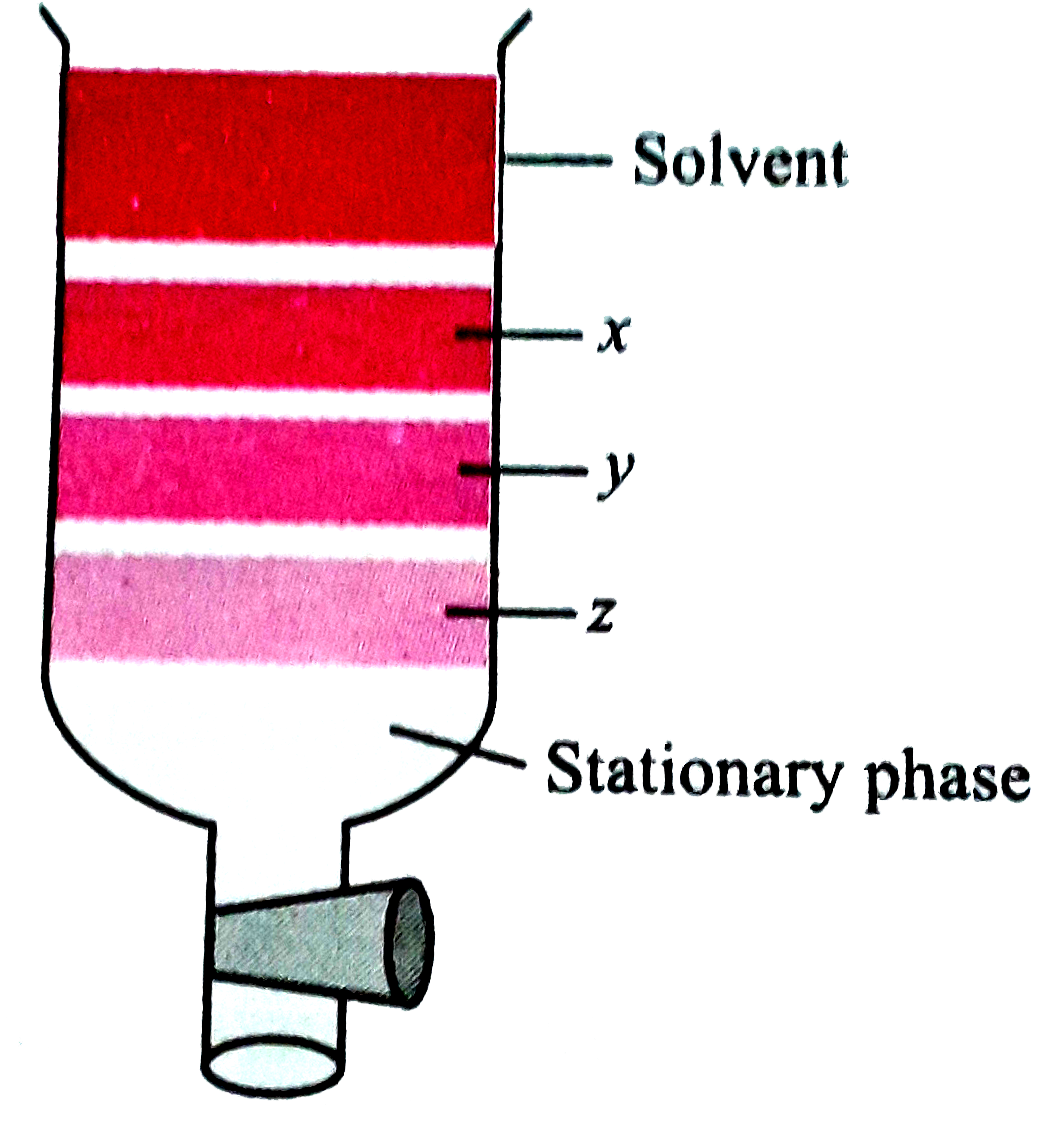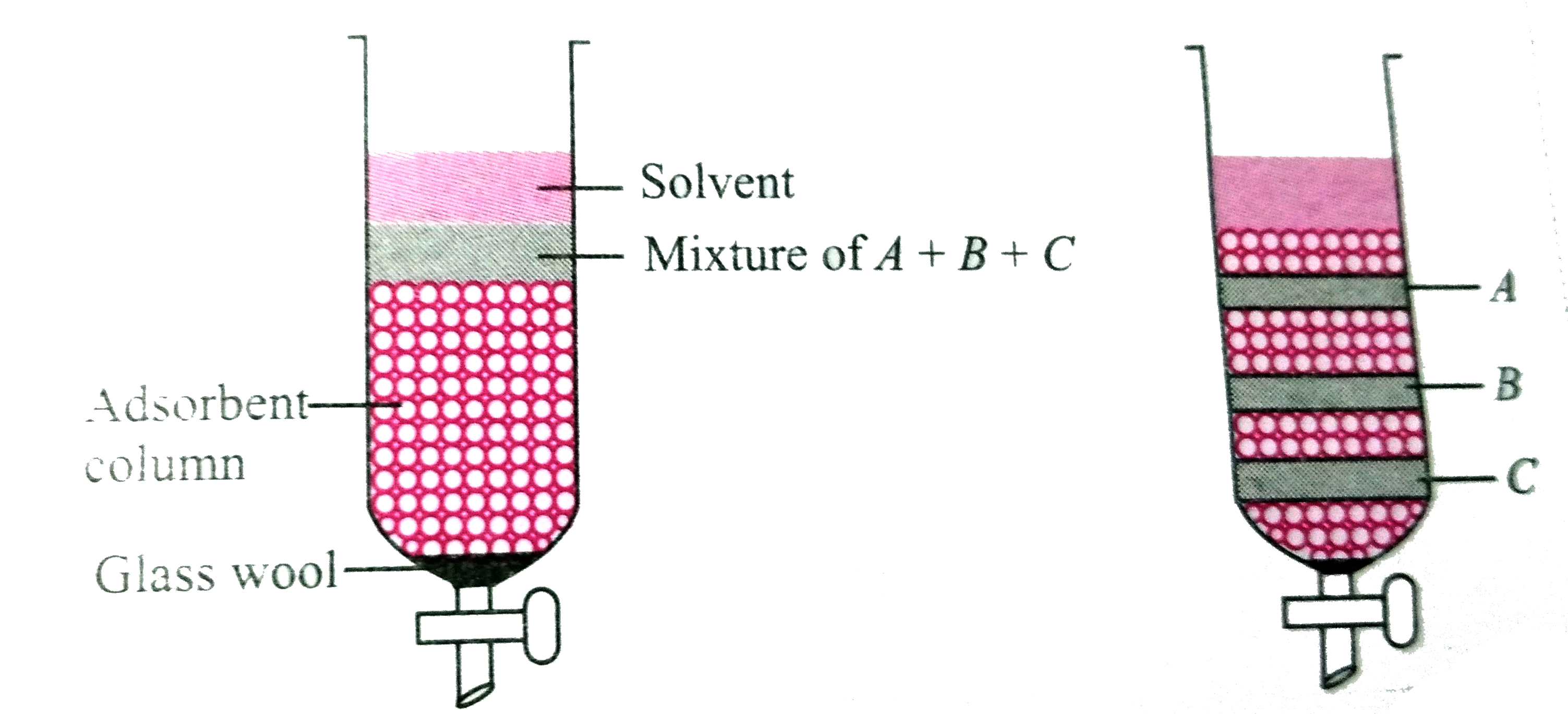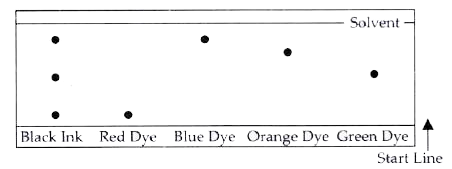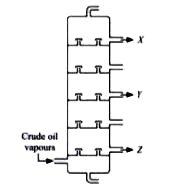Column chromatography involves separation of a mixture over a column of adsorbent (stationary phase) packed in a glass tube. Depending upon the degree of adsorption complete separation takes places . In the given column, three coloured bands x, y, z are formed . Identify the correct statement .

x,y and z are absorbed to the same extent.
The most readily adsorbed component is retained near the top(x)
The most readily adsorbed componenet comes down (z).
x, y, z layers are formed according to the wavelengths of the colours not on the basis of adsorption.
The correct Answer is:B
Depending upon the degree to which the components are adsorbed the bands are formed .The most readily adsorbed substances are retained near the top and others come down to various distances in the column.
Topper's Solved these Questions
- BOOK - NCERT FINGERTIPSCHAPTER - GENERAL PRINCIPLES AND PROCESSES OF ISOLATION OF ELEMENTSEXERCISE - Electrochemical Principle Of Metallurgy6videos
GENERAL PRINCIPLES AND PROCESSES OF ISOLATION OF ELEMENTS
- BOOK - NCERT FINGERTIPSCHAPTER - GENERAL PRINCIPLES AND PROCESSES OF ISOLATION OF ELEMENTSEXERCISE - Oxidation Reaction3videos
GENERAL PRINCIPLES AND PROCESSES OF ISOLATION OF ELEMENTS
- BOOK - NCERT FINGERTIPSCHAPTER - GENERAL PRINCIPLES AND PROCESSES OF ISOLATION OF ELEMENTSEXERCISE - Thermodynamic Principle Of Metallurgy23videos
GENERAL PRINCIPLES AND PROCESSES OF ISOLATION OF ELEMENTS
- BOOK - NCERT FINGERTIPSCHAPTER - ELECTROCHEMISTRYEXERCISE - Assertion And Reason15videos
ELECTROCHEMISTRY
- BOOK - NCERT FINGERTIPSCHAPTER - HALOALKANES AND HALOARENESEXERCISE - Assertion And Reason15videos
HALOALKANES AND HALOARENES
Similar Questions
Given below is a column ot adsorbent in which the mixture of compounds A+B+C is placed. When the solvent is poured through the column, the components are separated depending upon the degree of adsorption. Which of the given statements is correct?
 View Solution
View SolutionBhavna is a student of class IX in a city school. She has a five year old younger brother Bunty who is very naughty. Bhavna's mother, Mrs. Malikm had purchased a big bottle of nail poslish remover from the market about six months back. She had used less than half of this bottle so far. One day Mrs. Malik left this bottle on the dining table by mistake and went out of the house for some work. In her absence, Bunty opened the half empty bottle of nail polish remover and filled it by adding water in it. When Mrs. Malik came back, she was very angry with Bunty and scolded him for spoiling her expensive bottle of nail polish remover. Mrs. Malik was about to throw away his bottle containing nail polish remover mixed with water when her daughter Bhavna came back from school. She told her problem to Bhavna. Bhavna throught over this problem for a while and said that there was no need to throw away the mixture of nail polish remover and water She told her mother that she could recover pure nail polish remover from this mixture. Next day, Bhavna took the bottle containing this mixture to her school laboratory. With the permission of her teacher, Bhavna set up an apparatus which included a particular type of flask fitted will a tall column. She put the mixture of nail polish remover and water in the flask and heated it gradually. On heating nail polish remover was turned into vapour, which were cooled by a water condenser to obtain pure nail polish remover. Water was left behind in the flask. Mrs. Malik was very happy to get back her nail polish remover.
(a) What is nail polish remover ?
(b) State whether nail polish remover and water are miscible liquids or immiscible liquids
(c) Name the process used by Bhavna for the complete separation of mixture of nail polish remover and water. Also define this process.
(d) On what factors does the separation of nail polish remover and water mixture of nail polish remover and water. Also define this process
(d) On water factors does the separation of nail polish remover and water mixture by the above process depend ?
(e) Name the tall column used in the flask during the separation of a mixture of nail polish remover and water
(f) What values are displayed by Bhavna in this episode ?View Solution
Knowledge Check
- Question 1 - Select One
The separation of the constituents of a mixture by column chromatography depends upon their
ADifferent solubilities ‘BDifferent boiling pointsCDifferent refractive indicesDDifferentia1 absorption. - Question 2 - Select One
The separation of the constituents of a mixture by column chromatography depends upon their
Adifferent solubilitiesBdifferent boilig pointsCdifferent refractive indicesDdifferential adsorption - Question 3 - Select One
A special technique used nowadays for separation and identification of the constituents in a mixture is chromatography. The principle is based on difference in adsorption of constituents of a mixture by a surface of an appropriate adsorbent material or solid medium (stationary) phase. The rate of adsorption of a particular constituent depends upon its solubility in the solvent. Following diagram shows a chromatograph obtained for black ink :

Black inkAis a pure substanceBis a combination of four different dyesCcontains orange and blue dyesDcontains red, blue and green dyes.
A chromatography column, packed with silica gel as stationary phase, was used to separate a mixture of compounds consisting of (A) benzanilide (B) aniline and (C) acetophenone. When the column is eluted with a mixture of solvents, hexane : ethyl acetate (20 : 80), the sequence of obtained compounds is
View SolutionA chromatography column, packed with silica gel as stationary phase, was used to separate a mixture of compounds consisting of (A) benzanilide (B) aniline and (C) acetophenone. When the column is eluted with a mixture of solvents, hexane : ethyl acetate (20 : 80), the sequence of obtained compounds is
View SolutionFor the separation of red ink from blue ink a technique is used which is described below. Arrange the statements in a proper sequence.
(1) The blue and red ink form spots at certain distances on the paper.
(2) Paper chromatography is used for the sepration.
(3) Paper and solvent are taken as stationary and mobile phases, respectively.
(4) A narrow strip of paper with a line drawn is cut and a mixture of red and blue ink with the help of capillary is placed on the line marked on the paper.
(5) The papar is suspended in the closed jar with the help of hook.View SolutionThe given diagram represents a fractionating column where petroleum is separated into various fractions. Arrange the fractions X, Y, Z in order of decreasing boiling point range and identify the fraction that condenses first.
 View Solution
View SolutionAlthough every element is different from every other element, yet some elements have certain similarities. Based upon these similarities, the scientists after numerous attempts were are given. Based upon these multiple choice questions are ultimately sucessful in arranging the various elements into groups or chemical families in such a way that similar elements were put together. This arrangement of elements is called classification of elements and this led to the formulation of a periodic table. The periodic table is the most organising principle in chemistry. If you know the properties of any element in a group, or of the columns, of the periodic table, you can make a good guess at the properties of every other element in the same group and even the elements in the neighbouring groups. The first break through in the classification of elements, was provided by Russian chemist Dmitri lunovich Mendeleev. Taking the chemistry of the elements as his primary organising principle, he arranged the known elements by atomic mass and grouped them together according to their chemical reactivity He also observed that there occurred recurrence of elements with similar physical and chemical properties after certain regular intervals. On the basis of these similarities Mendeleev proposed his periodic law which states that physical and chemical properties of elements are a periodic function of their atomic masses Moseley suggested that atomic number was a better fundamental property of an element than its atomic mass. This forms the basis of the Modern periodic law. Thus, modern periodic law states that physical and chemical properties of the elements are a periodic function of their atomic numbers. In the modern long form of periodic table the elements are arranged in the increasing order their atomic numbers and the elements with similar properties repeat after regular intervals. Repetition of chemical properties of elements at regular intervals when arranged in a definite order is called periodicity of properties. This is due the recurrence of similar outer electronic configuration at certain regular intervals. The long form of periodic table may be divided into four main blocks known as s, p, d and f blocks depending upon the type of orbitals being filled up with the increase in atomic number in atoms of the elements. The nature of the block to which an element belongs depends upon the type of subshell which receives the last electron.
In the long form of periodic table, all the non-metals are collectively placed inView Solution

